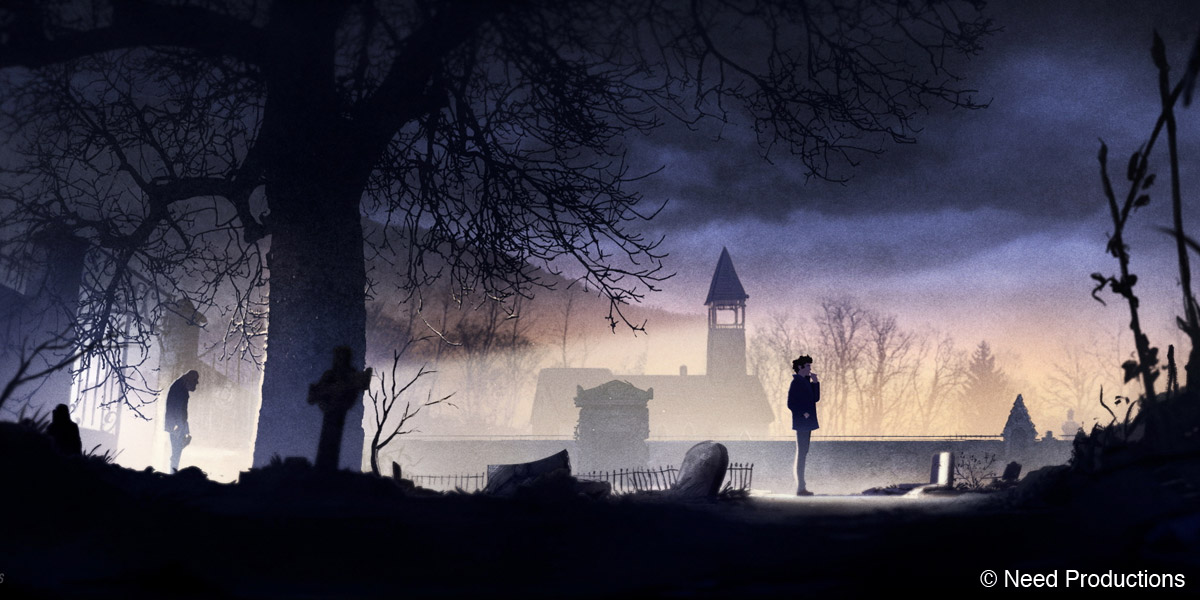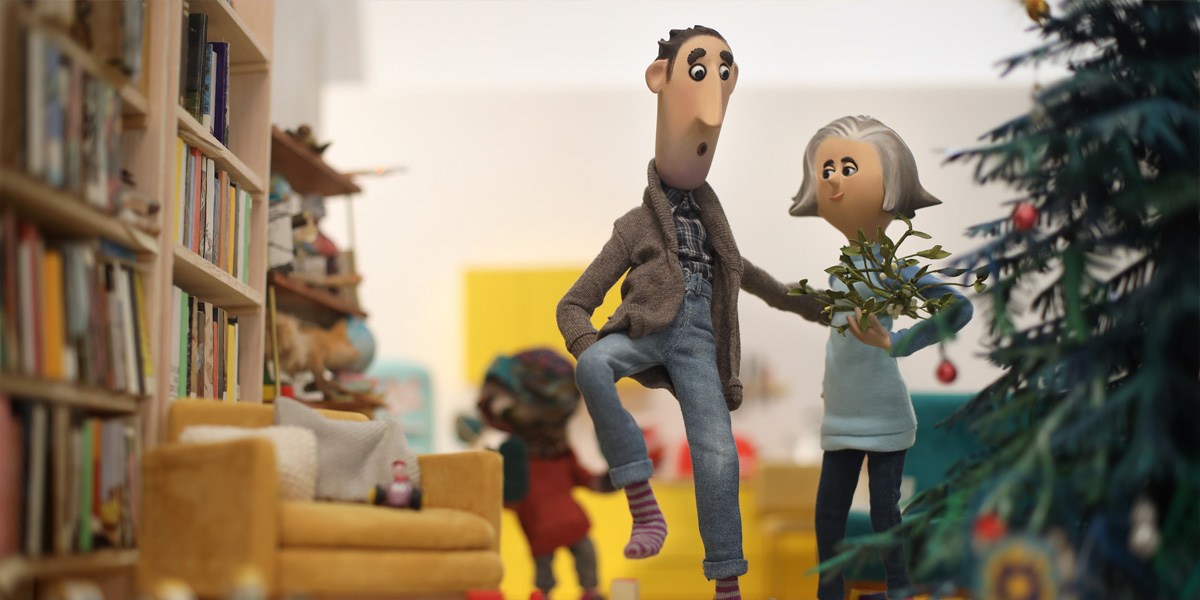Melvile
(Status: In Development)
Synopsis
After more than twenty-five years of absence, Paul Rivest returns to Melvile. He knows this little town pretty well, having spent all his summer vacations there as a child with his grandmother. Feeling responsible for the death of his first love and his best friend in a fire that destroyed the region the summer of his fifteenth birthday, his return to Melvile forces him to stir up the past. As Paul discovers the real reasons for Ruth and Thomas’s death, his stay in Melvile turns into a nightmare because the town of Melvile is not done with him.
Melvile
Directors: Romain Renard and Fursy Teyssier
Author: Romain Renard (Adaptation from Melvile by Romain Renard)
Scriptwriter: Olivier Tollet
Producer: Anne-Laure Guégan (Need Productions, Belgium)
Co-Producer: Sébastien Onomo (Special Touch Studios, France)
Target Audience: Young adults/adults
Technique: 2D digital, 3D digital
Format: 90’
Melvile is an animated feature film project aiming for a young adult/adult audience based on the comic series of the same title. It has gathered the largest audience at Cartoon Movie 2022. The film tells an adult-oriented, tightly plotted story that intersects in the characters’ past and present. It will be depicted in authentic 2D animation with an intense atmosphere and a refined visual style well-suited for a psychological thriller.
We heard the insightful story behind the film project throughout a special long interview with the three key people of the project: the directors Romain Renard and Fursy Teyssier and the producer, Anne-Laure Guégan.
Interview with Romain Renard, Fursy Teyssier and Anne-Laure Guégan

Hideki Nagaishi (HN): Could you let us know the key points of your animated feature film project that you would like to appeal to the prospective audience, including the message or experience you want to deliver through the film the most?
Fursy Teyssier: Melvile is the story of a man who is reminded of his past, who finds himself obliged to confront it and, in doing so, allows him to reinvent his future. It is a film in the form of an intimate investigation where past and present mix to reveal to our hero a terrible truth about his origins and the death of his first love. It is a drama, therefore, intended for an adult and young adult audience. A visual promise in a universe where tensions and atmospheres oscillate.
We assume our desire to confront ourselves with a genre film. Creating a genre film for animation is the challenge that has excited us since the beginning. To animate a story with drama, mystery, paranoia, all these ingredients that are the basis of a psychological thriller. But Melvile is also a film about love. Of many loves, of a teenage love and its repair in the present time. Despite the drama, there is always a light, a warmth that saves our characters.
HN: How did the film project start, and how and why did Romain Renard and Fursy Teyssier come to co-direct the film?
Anne-Laure Guégan: I discovered Melvile on paper at the Book and Comic Fair in Brussels in 2018. I discovered a prolific and fascinating universe. What immediately aroused my curiosity was Romain’s drawing and for me the obvious thing, when I thought about cinema, was that there was no question about bringing a film to life.
I met Romain very soon after. And if we decided very quickly to work together, it was not necessarily easy to find the author-scriptwriter who would finally collaborate with Romain to write the adaptation. It’s a very rich universe and it required a lot of work to refine without losing.
On the other hand, the meeting with Fursy was done very quickly and very naturally. We discovered his talent and his artistic direction for the sets of I Lost My Body (2019). Romain, like us, thought that a co-direction was necessary, because of his little experience in animation. But there was something strong that became apparent very quickly when they met. In addition to their common taste in drawing, they share their musical and cinematographic references. They have very different characters but they complement each other perfectly. Romain has been living with Melvile for 10 years, Fursy has just fallen in love with her, which creates a very good balance between the two.
HN: In your pitch at Cartoon Movie 2022, it was mentioned that the film’s story will be based on volume 3 from the original comic book series. What were your reasons behind that decision?
Romain Renard: Melvile is a comic book series in which each book can be read independently of the others. Each volume tells the story of an inhabitant of Melvile. But, the third volume is for me the most complete. In the series of books, it acts as a prequel and conclusion, we learn the circumstances of the creation of the city until its destruction in the present time. Unlike the other two Melvile volumes, the third volume is more choral; I spent a lot of time developing each of the characters. So we had a very rich base to start its adaptation. And then, unlike the other Melvile volume, in this one, there are two temporalities: the adolescent past and the present of the return. These two temporalities create a dynamic that enriches the story.
HN: What do you take care in the most when writing the script with Olivier Tollet for bringing the story from the original comic to an animated feature film format?
Romain Renard: In terms of comics, the story is very atmospheric, even contemplative. I can draw about twenty pages to tell a sunset, or even more when I tell the time it takes the light of a star to reach us! In addition to these sequences, special attention is given to the feelings of the characters. There too, I take the time to describe their moods, their reactions, etc. In doing so, I depart from the classic comic book paginations. The third volume is 400 pages long. 400 pages of all these moods.
So, of course, when we were working on the adaptation, we couldn’t stretch it out that far. We tightened up the plots, we made choices about where our characters would fit in, and above all we wrote it to be a cinematic object in its own right.
We kept the atmospheric singularity of the comic book, its mood, its atmosphere, but in the service of a film and a 90-minute plot by moving the sequences back and forth between the past and the present, each sequence feeding the other, but relying even more on the codes of a psychological thriller.
In order to fit into the feature film format, we had to make choices such as leaving out some subplots or merged some characters. We also worked a lot on the intertwining of the past and the present to create a breathtaking and dynamic story. In short, it’s a rewriting, a new angle, an reel adaptation.
HN: What is the most important characteristic and goal of the film’s visual design of the characters and universe of the story?
Fursy Teyssier: What is striking in Romain’s drawings are his powerful and realistic images, in contrast and light. It gives off an atmosphere of strangeness and this is what makes the identity of the comic book. One of the challenges of our research on the treatment of the decor One of the challenges of our research on the treatment of the decorations was to adapt while respecting its graphic universe and its singularity.
The characters of the comic book are very realistic, very demanding in terms of drawing, full of details, texture and matter. The intention in the adaptation was on the one hand to assume this realism, while going towards the economy of line.
By digging towards simplicity, we arrived at characters whose lines are relatively pure. The idea was not to distort what characterizes them, but with a minimum of graphic information to bring these characters to life and capture the essence of their personality. Their integration into the scenery was also the focus of our attention. The scenery is so important! They are what make us believe in the existence of the place. We wanted them to be as realistic as in the comic book. Our characters fit in as if they were joining a place that existed long before they appeared and would remain long after they left. That’s what makes the difference between these two treatments.
HN: As a film director and a comic artist, What are the advantages of telling a story in an animated film and in a comic, respectively? And what have you found attractive in each of these two mediums?
Romain Renard: In comics, there is practically no frame, everything is possible in the form of a narrative. The layout of a drawing for example can tell something, the reading path on a double page, the surprises that can be created by turning a page, it is a creation that is thought of by anticipating the complicity of the reader. It’s a whole series of graphic codes at the service of a narrative. But since the first Melvile, each book is accompanied by a soundtrack that I compose for the reading. From the beginning, there was a desire for total immersion. The creation of this film is the result of this desire. To make these emotions, these moods live on a screen, to accompany it with sound, with music, it is also the exploration of another narrative form where the reader becomes a spectator, where we control perhaps a little more than in comics what we want to make him share. There are a thousand and one ways to tell a story, each medium offers its possibilities, and cinema is one of the most exciting!
HN: What is important for you in creating a team for this film project?
Anne-Laure Guégan: At Cartoon Movie 2022, after the pitch, a lot of people told me: “It shows in a strong way to see that you all work together“.
That’s exactly what counts: being together. Moving forward together. Because an animated film project is a moving object that evolves and improves. And during all this phase of development, which requires work but sporadically and at a distance, we were able to verify that the team’s knot works very well.
It’s the same with Sébastien Onomo, our French co-producer at Special Touch Studios. We are very different, but we complement each other. It is for me, as for Romain, a first animation film as an executive producer and the presence of Sébastien and his great team, it gives me a great strength.










